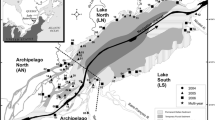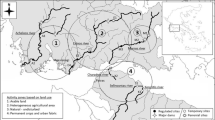Abstract.
Flood and flow pulses are primary factors that regulate macroinvertebrate community structure in river-floodplain ecosystems. In order to assess the impacts of these important hydrological events in a regulated Mediterranean river, bimonthly water and macroinvertebrate samples were collected in 2006 in the Middle Ebro River channel and six floodplain wetlands (NE Spain).We found significant differences among the river sites (permanently connected), two constructed wetlands (groundwater seepage) and three natural oxbow lakes (surface connected at 400, 800 and 1200 m3/s). River sites were dominated by aquatic worms (e.g., Naididae) and showed a high degree of eutrophication. Constructed wetlands provided new habitat for predatory insects (e.g.,Coenagrion scitulum and Trithemis annulata) that benefited from the absence of fish. Natural oxbow lakes were dominated by crustaceans (e.g., Atyaephyra desmarestii, Procambarus clarkii) and were highly overlapped in Correspondence Analysis. Canonical Correspondence Analysis, coupled with variance partitioning, showed that hydrological connectivity accounted for 28% of the variability in the invertebrate community, followed by physicochemical (10%) and trophic (7%) factors. Differences in frequency and duration of flood pulses in natural oxbow lakes were not enough to generate distinctive macroinvertebrate assemblages in the different wetlands. Analysis of variance showed that richness and total abundance increased with hydrological connectivity, while diversity showed a rather unimodal distribution. Generalized Additive Models indicated that among the measured environmental variables, nitrate concentration strongly affected the composition, abundance and diversity of aquatic communities. Our data indicate that increasing the diversity of water body types in degraded floodplains enhances biodiversity and aids in the functional and ecological recovery of the riverine landscape.
Similar content being viewed by others
Author information
Authors and Affiliations
Corresponding author
Additional information
Received: 25 June 2007; revised manuscript accepted: 27 February 2008
Rights and permissions
About this article
Cite this article
Gallardo, B., García, M., Cabezas, Á. et al. Macroinvertebrate patterns along environmental gradients and hydrological connectivity within a regulated river-floodplain. Aquat. Sci. 70, 248–258 (2008). https://doi.org/10.1007/s00027-008-8024-2
Published:
Issue Date:
DOI: https://doi.org/10.1007/s00027-008-8024-2




